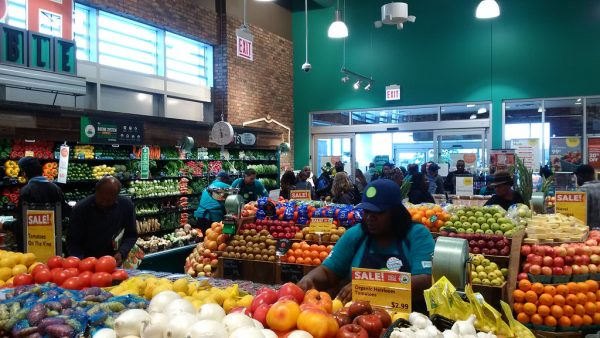In 2011, Erewhon rebranded itself from a mom-and-pop nutrition shop to a trendy, health-focused grocery chain. Mainly known for its smoothies and hot-bar items, the grocer gained popularity from its wide range of vegan and healthy products.
Celebrities such as Cara Delevigne, Miley Cyrus and Hillary Duff flooded Erewhon during the height of the COVID-19 pandemic. Their presence put Erewhon in the public eye and onto many TikTok For You Pages. As Erewhon continues to garner attention online, its high price tags spark conversation about the culture of healthy food shopping.
“The idea of being healthy has become synonymous with being an It Girl and has definitely been glamorized on social media,” said Lucia Ferris ‘24. “The stereotype feels almost cultish. I see a sense of community among people who shop at upscale grocery stores like Whole Foods and Erewhon. It’s definitely exclusive: some people are in on it, and others aren’t.”
Japanese immigrants Aveline Yokoyama and Michio Kushi founded Erewhon in Boston during the 1960s to sell foods integral to their diets. In Japan, Yokoyama and Kushi studied the practices of Japanese Author George Ohsawa, who wrote The Unique Principle: The Philosophy of Macrobiotics. The Unique Principle combines religion with science and dictates a person’s diet, among other lifestyle factors.
The Unique Principle’s dietary restrictions had no scientific backing. However, Ohsawa credited his decisions to a given food’s yin and yang energies. Erewhon’s owners applied this practice to the types of foods and brands they sold, offering wholesale and bulk selections of various organic grains.
Almost 60 years after the first Erewhon opened its doors, the grocery store still sells various health-focused products, though they are no longer centered around Ohsawa’s ideals.
In May of 2023, TikTok user Lizzie Dushaj (@lizziedushaj) posted a viral video of her trying Erewhon’s sea moss gel, a $44 product listed on the Erewhon website as one of its best-selling products. The gel is commonly consumed in a smoothie, such as Hailey Bieber’s trendy $19 skin glaze smoothie. For $44, the 16-ounce container of sea moss gel is valued at $2.75 per ounce, which is the recommended serving size.
Erewhon’s website states, “[The store’s wellness products] enhance [customers’] path to well-being. … Every product reflects [Erewhon’s] commitment to genuine health and holistic wellness.”
“There’s having a healthy lifestyle and making healthy choices, and then there’s buying arbitrary products [deemed as healthy],” said Ferris. “I’d rather purchase organic fruit and balance my diet instead of spending obscene amounts of money on products like vague [sea moss] that claim they’ll solve all my problems.”
Although Erewhon does not have a store in San Francisco, many are familiar with one of its top competitors, Whole Foods. Whole Foods currently has eight locations in the city, one of which is located on Haight Street.
“I never go to Whole Foods for lunch,” said Sameera Notaney ‘24. “I’d rather spend my money at Gus’s, where [lunch items are] cheaper. If it isn’t out of the way, I’ll grab snacks from Whole Foods, but I do most of my shopping at Safeway.”
Many grocery stores sell healthy food, so what drives people to associate stores like Erewhon and Whole Foods with having more nutritious products than other grocery chains?
“There’s definitely something about the ambiance of a store that entices me into it,” said Notaney. “At Erewhon and Whole Foods, the food I buy looks nice, and I know it’s good for me. Whereas when I go to Safeway, the fluorescent lighting is off-putting, there is nothing really aesthetic to look at, and I have to go out of my way to find organic items.”
“I’m not influenced by social media grocery hauls or anything of that sort, but I know that my friends are,” said Ferris. “Location, price and nutritional value are the three most important things to me when buying food. If it’s packaged nicely, that’s just a benefit.”

Cosmic berry sea moss and $19 smoothies
April 21, 2024
